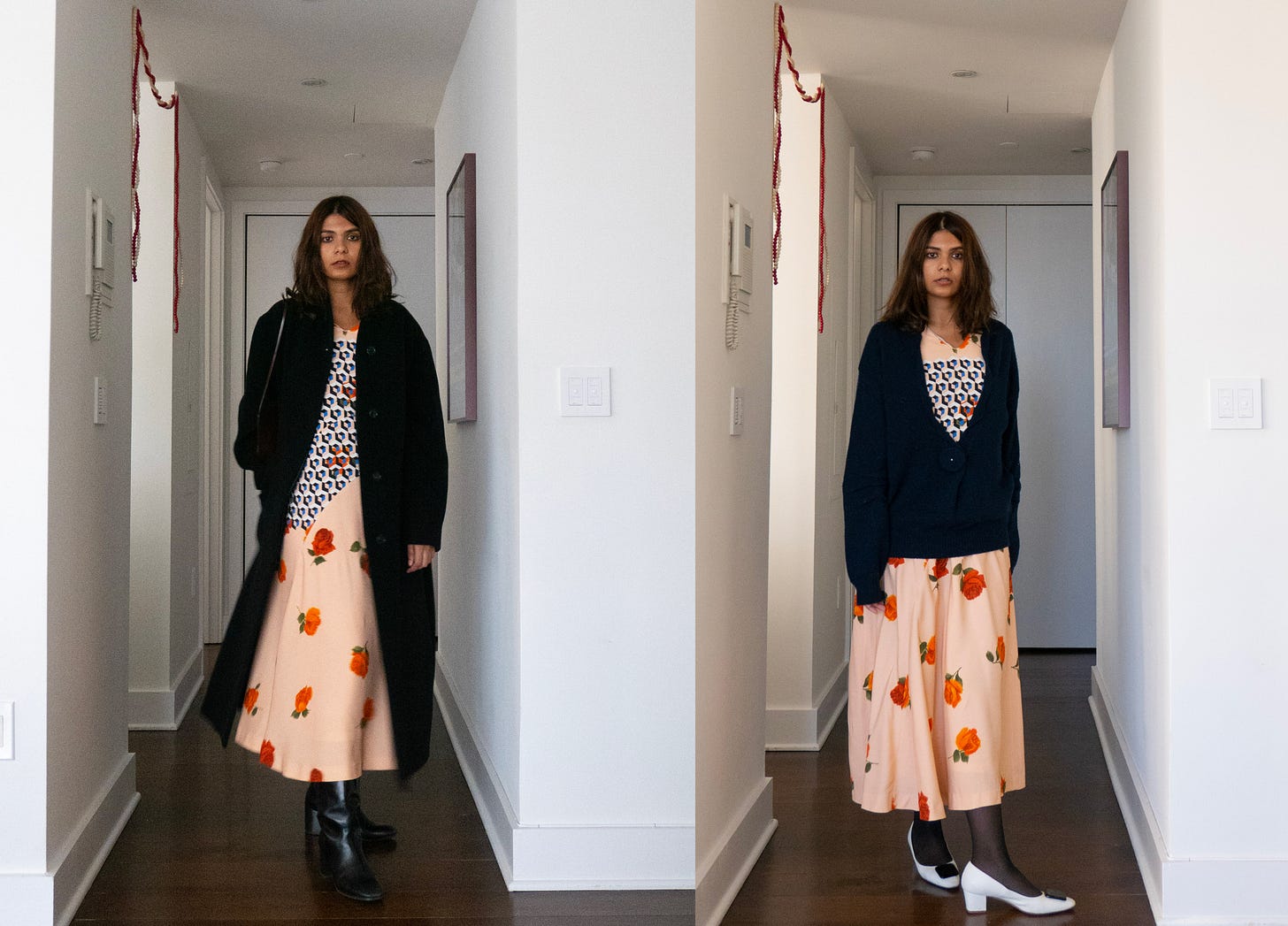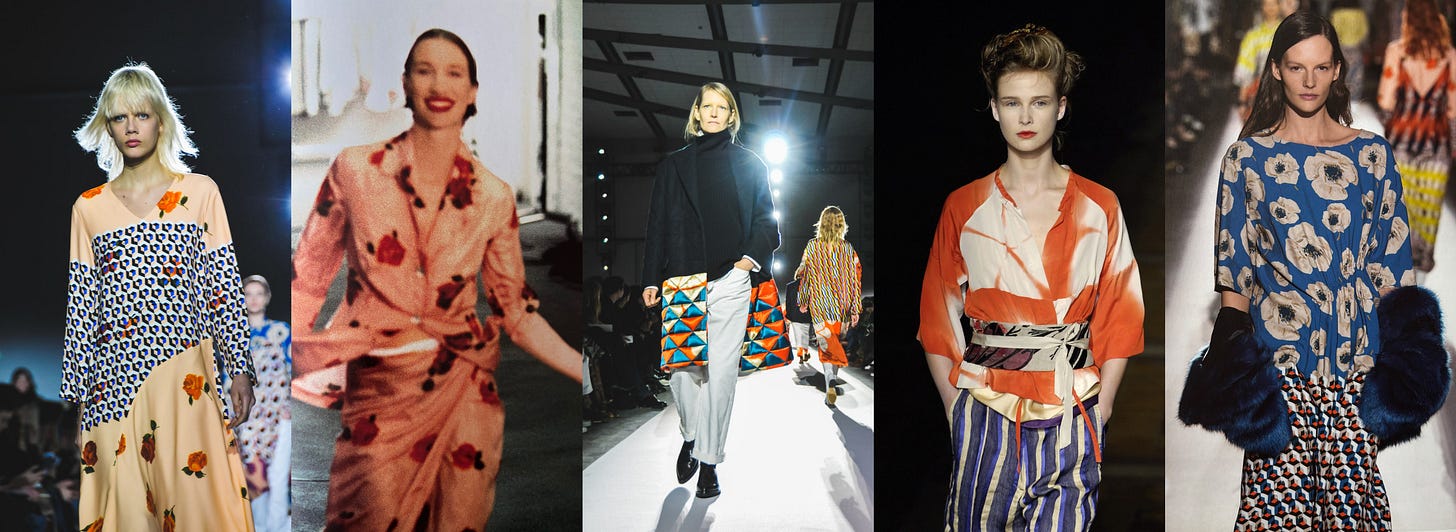037: Why I Collect Dries Van Noten Fall 2017
A celebration of the past in the forging of a future.
A dress is quite a final thing, closest in nature, I think, to a uniform. With a pair of trousers or a skirt, there are infinite possibilities. A suit raises the question of what to or what not to wear under. A dress in itself is complete, warranting fewer stages in the act of getting ready, and for the level-headed lot, exacting of less agonies.
I am very partial to dresses. There was a brief aberration during my adolescence, but I quickly came to my senses and it returned to favor. As an avid wearer of dresses, I have come to learn over the years that it can be a rather controversial garment. Often I have been met with a snide remark about wearing one in all kinds of weather, and to the snide: I thumb my nose at you. Time and time again, I have returned to the dress because it is what makes me feel most liberated and comfortable, and am less inclined to think cruelly of my body, something that the unrelenting seat of many a trouser makes me prone to.
But because I am me, myself, and I, there have been times when I have wavered in the face of a dress. Something about its concept is suspiciously…easy. What do you mean I don’t have to unload my entire closet all over the bedroom? Not having to crumple to the floor, undone by tops that won’t work with a skirt? I loathe the myth of effortlessness; I am wearing something for a reason, and my choice has been deliberate. If I were to dress effortlessly, I would permanently be in my pajamas. As you may have gleaned, I enjoy a struggle, and to keep things from becoming too smooth and simple, I do like a dress that is a bit fussy, maybe not so dictionary-definition pretty. A ruffled bust. One impossible to wear wing-like sleeve. A clash of prints set on a backdrop of what Suzy Menkes would perhaps classify as rotting-shrimp pink adjacent, or certainly shrimp cocktail-inspired.
The evolution of a rose from 1994 (set to Elvis Presley’s Love Me Tender) to 2017 (a mishmash of tunes from shows 1-100, my personal favourite is Bowie’s Heroes against the sounds of natural and city life):

Because I delight in looking like a snack 1980s hors d'œuvre, it did not surprise me in the least that I should fall madly for a Dries Van Noten dress from the designer’s 100th runway show in a shade of perishing shrimp, patterned with large cascading red roses, overlayed with a geometric print across the bodice and sleeves. This dress (along with a few tops), from Fall 2017, is a reinterpretation of styles that were shown during Dries Van Noten’s debut womenswear collection for Spring/Summer 1994. For the 1994 collection, each piece was washed for a softening effect, bright red roses (the designer’s favourite) turning a romantic muted hue.
Aside from the use of the rose pattern on pink, there are a few other serendipitous parallels between the 1994 and 2017 collections. Prior to his first womenswear runway show, Dries had made a promise to himself that when the time should come, Pat Cleveland would walk in it, which she indeed did. Fall 2017 saw the return of models with whom Dries had launched his career, including Kristina de Coninck, who often modeled the designer’s womenswear before its official launch. For Spring/Summer 1994, attendees were given no assigned seats to signal they were all of equal esteem, while in 2017, all guests took their places in the front row. Dries returned to this somewhat egalitarian move throughout his career, a rarity in the age of the hierarchical circus of the front row, where those without a high enough follower count are fated to be pinned against a wall.
What I am drawn to most about Dries Van Noten’s designs for his 100th show is the way in which it looks back to move forward. The past is not shrouded in dust, but rather fragments are collected from moments that brought Dries acclaim, pieces of that which made the designer who he is today, celebrated as something new. Dries is steadfast in his loyalty, from the craftspeople in Kolkata he has collaborated with over the years, to his clients and most ardent supporters. So why not also be loyal to the very fabric of his work? There is genius in being so forward-thinking, a print now over thirty years old remains fresh and very much unlike anything in the market today. Somewhere between the seams there is a lesson about honoring the place from where we started as we progress through life.
Regarding this treasuring of the past, in her review of Dries Van Noten’s Fall 2017 show for the Washington Post, Robin Givhan writes, “Van Noten kept his audience focused on beauty, variety, imperfections, individuality. And perhaps most important: continuity. That’s not something that fashion focuses on often. The industry is primarily obsessed with moving forward, searching for the next thing. Of course, that means that obsolescence is guaranteed. As fashion pushes toward the future, the previous season is nudged aside. The past, while a source of inspiration, is not something to celebrate. It must be reinvented, subverted or, occasionally, memorialized. Van Noten manages to keep his past with him, maintaining its vitality and allowing it to inform his current work. The new looks are in dialogue with the ideas that have preceded them.”
Givhan concludes her review with this observation, “Prints are personal. A lot of designers use them, but many people don’t like to wear them — at least not in public life…Prints can be distracting and polarizing. They can be overwhelming and jarring. Each one has its own distinct personality. They are ethnic and tribal. They are vibrant and alive with all of the contradictions and aggravations that reside within us. They’re a fashion risk. But one worth taking.”
Prints do largely absent themselves from the repertoire of even the styliest of street stylers. Personal style, as we’ve come to understand it today, is perceived as most successful when replicated with a few quick clicks. That personal style is potentially an amalgamation of meditations and anxieties of the day is quite a scary matter, because it exposes our vulnerabilities, communicating who we are and where we’re going. That we are all, in fact, vastly different. Prints, and oddly more so in the wintertime, come off as a bit much; winter is a staid affair and black is the order of the day. Prints clash with the appearance of sobriety, and I have a tiny suspicion that prints upset the dominance of a classist white aesthetic that projects abundant wealth (and limited knowledge).
For some time, I imagined floral and graphic prints were to only be reserved for the warmer seasons, when the arbitrary codes of fashion allow us to have some fun. And though Dries Van Noten has never been one to shy away from colour and patterns, his Fall 2017 took his signature sense of play to a new level: why not spring for the turn of fall, summer for the chilly winter? It questioned rules that determine social class, said to hell with order! I liked what he was saying and how I felt in my first piece from this show, and trolled resale sites to see what else I could find: a blue floral and graphic print dress in a most unsexy cut, ruching to one side and abbreviated batwing sleeves, worn by Sara Blomqvist with an electric blue chubby faux fur coat on the runway, and a very large wool coat, discretely quilted and padded for warmth, business on top, with the party on the bottom a celebration of a print from Spring 2006.
One of the most valuable takeaways from this collection has been that one does not need to reject the past to forge forward. The viciousness of trend cycles proposes that all must be abandoned this very minute for something brand new that retains its luster for a fast-fleeting instant, before there is once again something new. Good design, I think, embraces the entire journey; it doesn’t just take into account the now, but also how it will endure thirty years later. It tells the story of a life lived. Very few designers are unafraid to honor the trajectory of their careers. Jean Paul Gaultier is one, Miuccia Prada, Dries Van Noten. It’s the legacies of those who hold true to who they are and what their work communicates that we hungrily return to and revere, not the flash in the too-hot pan.






I was just in Antwerp- second hand runway Dries everywhere for an average of $100 euro. You have to go 🤍🤍🤍 I’ll give you a list of my favs if you find yourself over there.
As always- a great read! Xx
Lovely